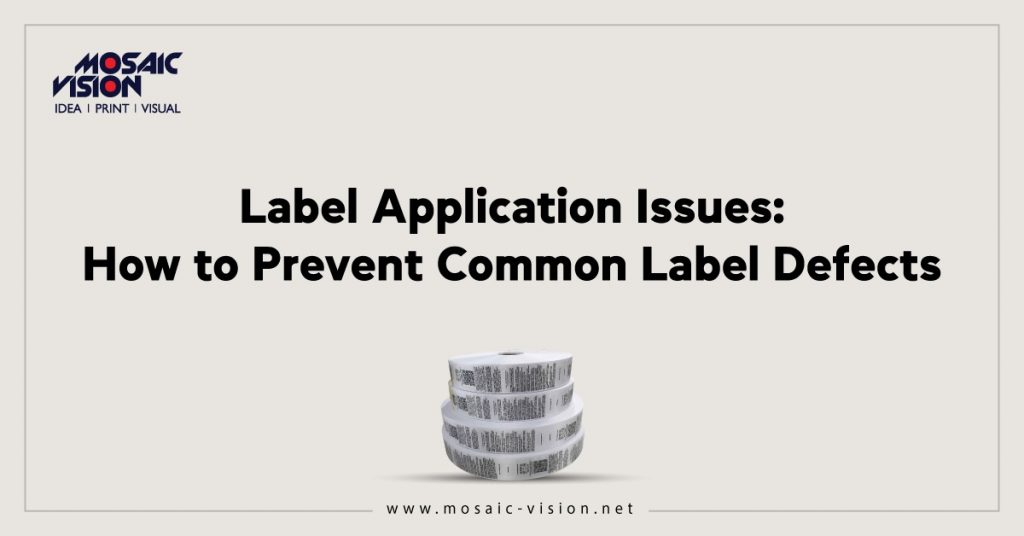
A good label sends a strong message to potential customers. Unfortunately, incorrect application can turn a promising opportunity into a negative image for your company. Label flaws can take many forms, ranging from minor errors to complete failure. Typical problems include:
- Wrinkles
- Darting
- Bubbles of air
- Cupping
- Lifting of the edge
- Tearing occurs during application.
- Adhesive is not adhering
Defects detract from your product labels, whether they’re caused by incorrect adhesives, applicator difficulties, or a harsh environment. Each flaw will detract from your brand’s appeal (if the labels are able to attach to your container in the first place). As a result, it’s critical to pinpoint the root of these problems and take action to address them.
Potential Causes of Label Application Issues
There are a number of reasons why a label could wrinkle, cup, or fall off completely. Of course, each case is unique, depending on a variety of elements such as the sort of goods you sell or the label material and adhesive combination you choose. Once the problem has been discovered, your label manufacturer and applicator may make the necessary changes to ensure the best possible label performance. Consider the following possible causes of label failure when determining the source of your label failure.
The container
Knowing your container is one of the first stages in spotting potential problems. It’s critical to understand the dimensions of your container so you can design around them. When you don’t know your container’s dimensions, your label may wrinkle or trap air bubbles when you apply it. A square label, for example, will not fit correctly on a tapered bottle. You may help minimize darts or wrinkling early on in the process by tapering your label to meet your specifications.
If you require these measurements, you should inquire with the maker of your container. You may have already received a “mechanical,” which is just a spec document for your containers, if you utilize glass bottles.
It’s also crucial to remember that the surface of your container has an impact on label placement. For example Lower-quality glass may be pitted or more stiff than smooth. These small peaks and valleys on the surface of your container will trap air under your label when you apply it, increasing the chances of visible bubbles.
The application environment and process
In addition to the container itself, it’s critical to examine the container’s condition as well as the environment in which it’ll be used. The materials and adhesives that are best for your labels are heavily influenced by environmental circumstances. If you don’t plan for things like temperature, moisture, and potential contamination, you’ll end up with peeling or label failure.
Labels on beer cans are a good example of this problem. When a brewery prefills a can and covers it with a lid, the cans are rinsed, making them wet. This condition necessitates the use of a wet application adhesive. Given the nature of water and adhesive, these solutions aren’t foolproof, but they’ll be far more effective than a regular adhesive. If moisture is still an issue, an air knife can be used to blow condensation off the can and reduce the likelihood of label defects.
Of course, you won’t be able to address these difficulties until you study your application environment and inform your label manufacturer. Even minor facts can save you time when troubleshooting. A sour beer, for example, may require a different adhesive or material solution than a typical lager, because the acidity in the sour beer can promote oxidation between the aluminum can and the metallic BOPP material.
Belt problems
Another potential source of worry is the applicator’s wrap belt. The belt can create a static charge as it moves the cans forward in some cases. That static charge might pull on the label, making it crooked or ripping it off completely at the belt area. As a result, whoever is at the end of the applicator will have to patch the impacted containers – and that’s assuming you’re using an adhesive that can be removed after use.
A number of factors can result in a static charge. There may be too much pressure on the belt in some circumstances. In other words, the belt may not be under enough tension. Certain circumstances may necessitate the use of anti-skid tape to reduce friction and static on the belt. This method is very useful for labels that have a matte or soft touch finish. The wipe down pads may accidently suck labels off containers due to the hydrophilic nature of these laminations. Anti-skid tape or even sandpaper can be used to provide the backing pad a lower surface energy than the lamination, reducing the chances of label removal by accident.
Liner issues
Your liner label may be the source of application troubles in some cases. Paper or transparent plastic liners are available on labels, but some applicators are unable to use one type of liner and not the other.
Although the liner you choose has little impact on the die cut, it does. You’re basically pushing down on that liner when you cut out the contour of the label. Because the clear liner is plastic, you can press down harder. Pushing too hard on the paper can cause a minor hairpin split that is difficult to see. However, if the slightly split paper line is connected to an applicator, the applicator’s pressure and strain can rip the liner, forcing you to stop production and resplice the roll.
In this case, a clear liner would be the best option as long as your applicator can manage the change. Although each applicator contains a sensor, some of them aren’t set up to operate with a clear liner. Consider trying to scan anything that is completely clear it doesn’t always register. To avoid ripping, you may need to purchase a specific sensor in this scenario.
Improper storage
Another possible source of label faults is the way labels are stored before use. Certain environmental conditions, such as storing your labels in an area that is too hot, cold, dry, or damp, can have an effect on their success. Typically, labels should be stored in a temperature-controlled environment — the exact temperature and humidity will vary depending on the label, so request this data from your label printer if you intend to keep them before using them.
While all labels are affected by environmental conditions during storage, shrink sleeve labels are particularly difficult. Shrink sleeves are composed of particular materials that make them more vulnerable to harm before being used. Shrink sleeves can bend or even melt due to extreme heat, cold, or other uncontrollable environmental variables, resulting in distortion or full failure. As a result, these labels necessitate refrigerated trailers for transportation and have certain storage requirements to avoid waste.
Another important factor for probable faults is shelf life. Labels usually come with a one-year warranty, so don’t wait any longer than that because the glue will lose its effectiveness if it sits for that long.
Work with a Collaborative Label Printing Company
Communication is the most effective method for preventing label problems. Blue Label works with you to identify potential hazards and provide solutions for your label issues, from air bubbles to wrinkles. Our professionals form a collaborative connection with our customers to learn the ins and outs of their labeling process so that they can avoid problems or troubleshoot them afterwards.
